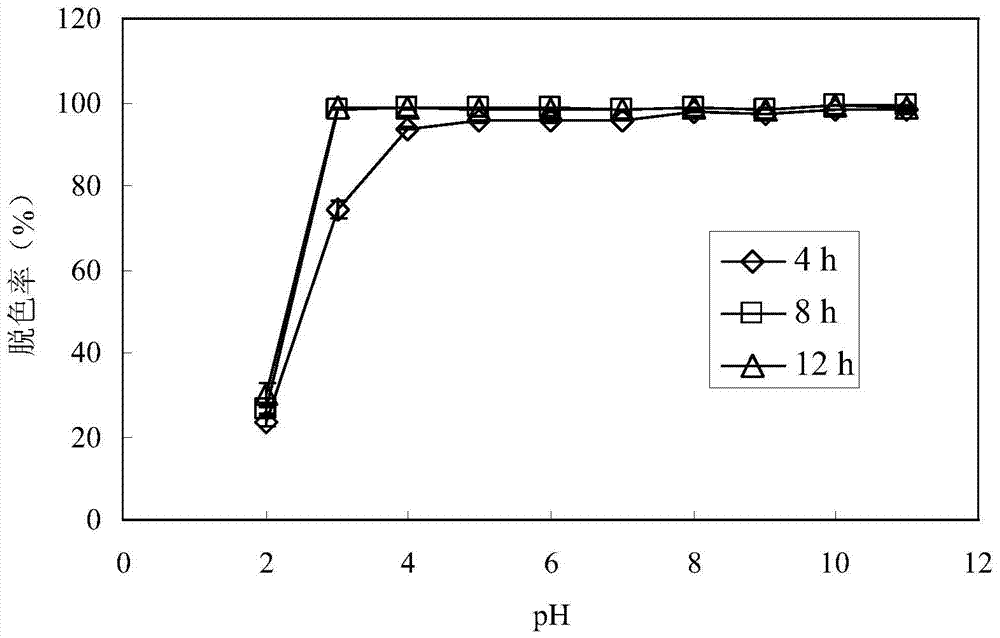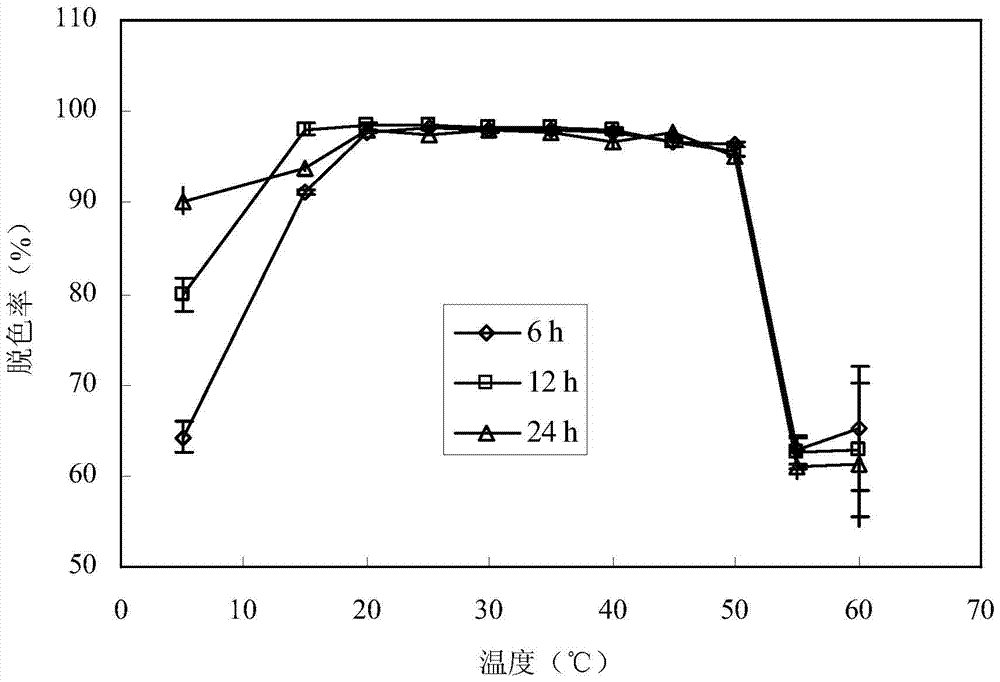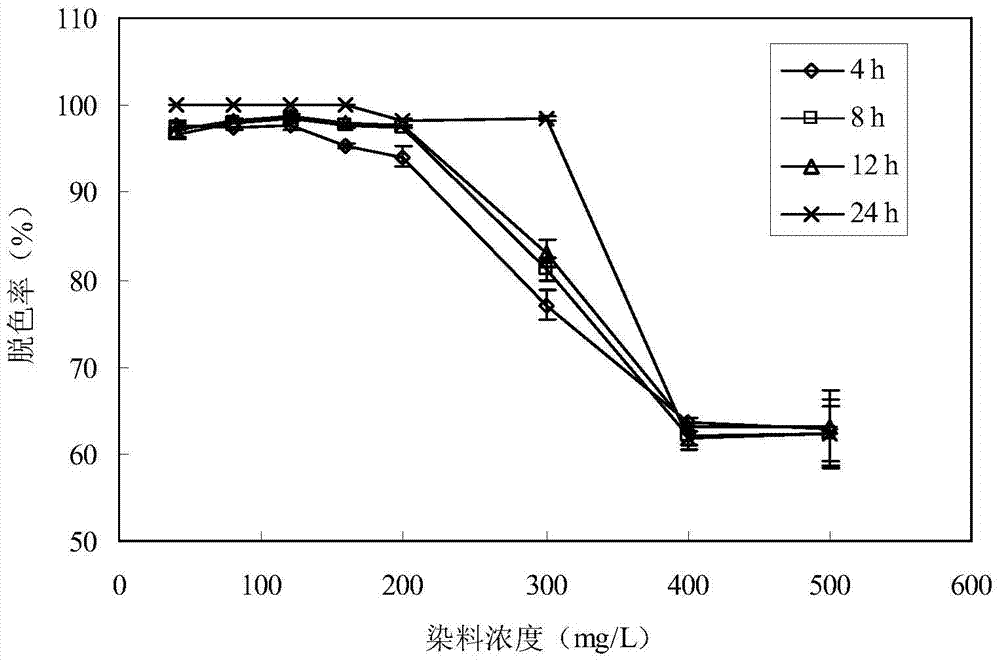A strain of Serratia for degrading triphenylmethane dye and method for degrading triphenylmethane dye
A technology of triphenylmethane and Serratia, which is applied in the directions of microorganism-based methods, chemical instruments and methods, biochemical equipment and methods, etc., can solve the problems of difficult treatment of polluted water bodies, and achieves low treatment costs and environmental adaptability. Strong and promising effect
- Summary
- Abstract
- Description
- Claims
- Application Information
AI Technical Summary
Problems solved by technology
Method used
Image
Examples
Embodiment 1
[0026] Example 1, such as figure 1 shown
[0027] Serratia WKD was inoculated in LB medium and cultured overnight at 30°C in a shaker with a rotation speed of 180rpm to obtain an overnight culture; based on the dry weight of the overnight culture, the overnight culture was 0.1g / L The material was inoculated in wastewater containing triphenylmethane dye crystal violet, and the pH was set to 2.0, 3.0, 4.0, 5.0, 6.0, 7.0, 8.0, 9.0, 10.0, and 11.0, and cultured with shaking at 30°C and 180rpm, and timed Sampling and determination, the sampling time is 4h, 8h and 12h respectively. After the collected samples were centrifuged at 10 000 rpm for 10 min, the supernatant was taken, and the absorbance was measured at 585 nm (λmax of crystal violet) with an Evolution 300 UV-Vis spectrophotometer to calculate the decolorization rate.
[0028]When the pH is in the range of 3.0-11.0, the decolorization rate of crystal violet can reach nearly 100% after decolorization for more than 8 hours....
Embodiment 2
[0029] Example 2, such as figure 2 shown
[0030] Serratia WKD was inoculated in LB medium and cultured overnight at 30°C in a shaker with a rotation speed of 180rpm to obtain an overnight culture; based on the dry weight of the overnight culture, the overnight culture was 0.1g / L The material was inoculated in wastewater containing triphenylmethane dye crystal violet, and the set temperatures were 5°C, 15°C, 20°C, 25°C, 30°C, 35°C, 40°C, 45°C, 50°C, 55°C and 60°C , and shake culture under the condition of 180rpm, and take samples regularly for measurement, and the sampling time is 6h, 12h and 24h respectively. After the collected samples were centrifuged at 10 000 rpm for 10 min, the supernatant was taken, and the absorbance was measured at 585 nm (λmax of crystal violet) with an Evolution 300 UV-Vis spectrophotometer to calculate the decolorization rate.
[0031] In the temperature range of 15-50°C, the 6h decolorization rate of strain WKD to crystal violet is maintained a...
Embodiment 3
[0032] Example 3, such as image 3 shown
[0033] Serratia WKD was inoculated in LB medium, and cultured overnight at 30°C in a shaker with a rotation speed of 180rpm to obtain an overnight culture; based on the dry weight of the overnight culture, 0.1g / L of the Overnight cultures were inoculated into wastewater containing the triphenylmethane dye crystal violet at concentrations of 40mg / L, 80mg / L, 120mg / L, 160mg / L, 200mg / L, 300mg / L, 400mg / L and 500mg / L, cultured with shaking at 30°C and 180rpm, and sampled regularly for measurement, the sampling time was 4h, 8h, 12h and 24h respectively. After the collected samples were centrifuged at 10 000 rpm for 10 min, the supernatant was taken, and the absorbance was measured at 585 nm (λmax of crystal violet) with an Evolution 300 UV-Vis spectrophotometer to calculate the decolorization rate.
[0034] With the increase of the dye concentration, the decolorization rate of strain WKD to crystal violet is gradually decreasing. When the...
PUM
 Login to View More
Login to View More Abstract
Description
Claims
Application Information
 Login to View More
Login to View More - R&D
- Intellectual Property
- Life Sciences
- Materials
- Tech Scout
- Unparalleled Data Quality
- Higher Quality Content
- 60% Fewer Hallucinations
Browse by: Latest US Patents, China's latest patents, Technical Efficacy Thesaurus, Application Domain, Technology Topic, Popular Technical Reports.
© 2025 PatSnap. All rights reserved.Legal|Privacy policy|Modern Slavery Act Transparency Statement|Sitemap|About US| Contact US: help@patsnap.com



